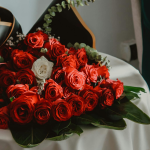Roses are not just beautiful flowers — they are symbols that carry deep emotional meanings. From ancient mythology to Victorian-era flower codes, each rose colour has developed a personality of its own. By understanding the significance behind rose colours, you can elevate a simple bouquet into a heartfelt message.
At Eros Florist, we believe that flowers speak louder than words. This guide will walk you through the symbolic meaning, historical background, and ideal occasions for gifting each colour rose.
Red Roses: Love, Passion, and Romance
Red roses have long been considered the ultimate symbol of romantic love. This rose colours association with passion and desire dates back to ancient Greek and Roman mythology, where red roses were linked to Aphrodite and Venus, goddesses of love. One myth tells of red roses springing from the ground where Aphrodite’s tears and her lover Adonis’s blood fell.
In the Victorian era, when expressing emotions openly was frowned upon, red roses became the discreet but powerful language of true love and deep admiration. Today, they remain the classic choice for anniversaries, Valentine’s Day, and romantic gestures — a timeless way to say “I love you” with flowers.
White Roses: Purity, Reverence, and New Beginnings
White roses evoke feelings of purity, innocence, and serenity. Historically, they have been associated with spiritual love and were used in religious ceremonies across many cultures. Their use in weddings became more common after Queen Victoria famously carried white roses in her bridal bouquet in 1840, symbolising a pure and sacred beginning.
In Victorian flower language, white roses were used to express reverence and silent remembrance, making them appropriate for funerals and memorials as well. Today, they remain a favourite for bridal arrangements, christenings, and occasions that mark a new chapter in life.
Pink Roses: Gratitude, Joy, and Sweetness
Pink roses are among the oldest cultivated rose varieties and have always been associated with elegance and grace. In ancient gardens across the Middle East and Asia, pink roses were revered for their delicate appearance and soothing scent. Their symbolism developed over centuries to include feelings of admiration, appreciation, and joy.
Light pink roses often express sympathy and gentleness, while deeper shades show thankfulness and admiration. In Victorian times, sending pink roses meant you were grateful for someone’s presence or kindness. They remain a versatile and cheerful option for birthdays, thank-you gifts, and expressions of friendship.
Yellow Roses: Friendship, Joy, and Positivity
Yellow roses bring sunshine to a bouquet. Initially introduced to Europe from the Middle East in the 18th century, this rose colour’s meaning evolved dramatically over time. While they were once thought to symbolise jealousy, by the 19th century, they had come to represent warmth, friendship, and happiness.
In the language of flowers, yellow roses are the best way to say “I’m thinking of you” or “Thanks for being a great friend.” They are a wonderful choice when you want to spread cheer, whether someone is recovering from illness, celebrating a promotion, or simply in need of a little sunshine.
Orange Roses: Desire, Fascination, and Energy
Orange roses are a vibrant, modern addition to the floral world. These rose colours were developed through the hybridisation of red and yellow roses in the 20th century and quickly gained popularity for their bold, fiery tones. Their colour represents enthusiasm, fascination, and sometimes budding passion.
In the language of flowers, orange roses are often sent to express admiration and energy — like saying, “I’m proud of you” or “I can’t stop thinking about you.” Their bright hue makes them perfect for celebratory occasions or to add a sense of excitement to any floral arrangement.
Lavender Roses: Enchantment and Love at First Sight
Lavender roses are rare and enchanting. Their soft purple tones suggest a magical or almost ethereal quality, which is why they are often associated with enchantment and love at first sight. These roses are relatively new, created by modern rose breeders seeking something out of the ordinary.
In traditional floriography, lavender roses send a message of mystery, admiration, and wonder. They are ideal for new relationships, secret admirers, or moments when you want to leave a lasting impression on someone special.
Black Roses: Farewell, Rebirth, and Mystery
Though black roses don’t grow naturally, florists dye deep red or purple roses to achieve this dramatic and striking colour. Historically, they have been associated with death and mourning, but their symbolism has grown to include rebirth, strength, and farewells.
Black roses have been featured in gothic literature and art for centuries, representing mystery, courage, or major life transitions. While they are often used in funerals, they can also be given to mark the end of a chapter — whether it’s the closing of a career, a relationship, or a personal transformation.
Mixed Roses: Complex Emotions and Thoughtful Gestures
A mixed bouquet of roses brings together various meanings into one harmonious arrangement. This concept became popular during the Victorian era when people used flower combinations to convey layered or complex emotions. For example, combining red and yellow roses could mean “Congratulations on your success,” while red and white roses together symbolise unity.
Mixed rose bouquets are perfect for birthdays, celebrations, or moments when you want to express multiple sentiments — love, joy, admiration — all in one beautifully curated floral gesture.
Modern Language of Flowers
In the Victorian era, the “language of flowers”, or floriography, was almost a secret code. Each flower and colour had a strict definition, as we have seen above, allowing people to send covert messages in a time when open emotional expression was frowned upon. But like all languages, the meaning of flowers has evolved over time. Enter the modern language of flowers, a more fluid, expressive, and creative approach to floral symbolism.
Unlike the rigid rules of the past, modern floriography is all about personal interpretation. Today, the meaning of rose colours isn’t fixed; it’s shaped by the emotions of the giver, the intent behind the arrangement, and even the cultural context of the moment. For instance, where once yellow roses were seen as a sign of envy, they are now celebrated as a joyful expression of friendship and warmth. This flexibility allows individuals to communicate emotions in ways that are meaningful to them, not just by historical definitions.
Modern floral arrangements are no longer solely designed to communicate a precise message, they’re also crafted to evoke a mood or atmosphere. A soft blush-toned bouquet may be chosen to reflect calm and serenity, while a dramatic arrangement of deep reds and purples might aim to stir passion, mystery, or nostalgia. The emphasis has shifted from what the flowers say to how they make someone feel.
This modern approach also opens up the floral space to artistic expression. Designers and florists now use flowers like artists use paint to explore emotion, movement, contrast, and harmony. A mixed bouquet might not be trying to “say” anything in particular, instead, it may represent a journey, a personality, or a visual metaphor for an experience or relationship.
Another hallmark of modern floriography is its inclusivity and flexibility. Where traditional rose arrangements might have stuck strictly to three or four varieties, today’s florists mix roses with unusual foliage, wildflowers, dried elements, or even tropical blooms to create arrangements that feel dynamic and contemporary. The focus is less on historical accuracy and more on aesthetic appeal and the overall message of the arrangement.
Colour and texture also play a major role. Florists today view roses not just by their meaning, but by how their colour palette and physical structure contribute to the composition. A bouquet featuring velvety deep red roses alongside pale pinks and creamy whites may be meant to evoke a sense of romantic complexity, a tapestry of affection, admiration, and passion. Textural elements like eucalyptus sprigs or wispy baby’s breath might be added to soften or dramatise the composition, depending on the desired emotional tone.
In essence, the modern language of flowers draws from the rich traditions of Victorian floriography, but with a generous helping of freedom, creativity, and personal meaning. It allows people to present roses not just as gifts, but as storytelling tools, ways to reflect their feelings, style, and sentiment with beauty and intentionality.
Whether you’re creating a moody hatbox of deep burgundy roses for a dramatic impact or a vibrant heart-shaped arrangement of mixed blooms to celebrate a joyful moment, modern floriography reminds us that roses don’t just carry meaning, they create it.
Final Thoughts from Eros Florist
When it comes to roses, colour matters. From red roses declaring eternal love to yellow roses celebrating friendship, each hue carries a deeper message. By choosing the right rose colours, you’re not just giving flowers — you’re sharing a story, a feeling, a moment.
At Eros Florist, our expert team is here to help you say it beautifully with a variety of rose colours. Browse our curated rose collections and let your bouquet do the talking. Order online today and make your message bloom.
FAQs
What are the different colours of roses?
Roses come in a wide variety of colours, including red, white, pink, yellow, orange, lavender, black (dyed), and mixed. Each colour carries its own symbolism and emotional message, making rose selection a meaningful part of gift-giving.
How many real rose colours are there?
Naturally occurring rose colours include red, pink, white, yellow, and shades of orange. These core colours result from genetic variations in wild rose species. However, thanks to centuries of hybridisation, there are now thousands of cultivars displaying a wide range of hues, including lavender, peach, coral, and bi-coloured varieties. While some colours like blue or black roses do not exist naturally, they are often created through dyeing or selective breeding.
What is the rarest rose colour?
The rarest rose colour is blue. True blue roses do not exist in nature because roses lack the specific pigment (delphinidin) needed to produce a blue hue. What we often see as “blue roses” are either white roses dyed blue or specially bred hybrids with purplish undertones. Because of their rarity, blue roses are often associated with the unattainable, mystery, or the extraordinary.
What is the most popular rose colour?
Without a doubt, the most popular rose colour is red. Universally recognised as the symbol of love and romance, red roses are a go-to choice for Valentine’s Day, anniversaries, and romantic occasions. Their classic appeal, emotional depth, and traditional symbolism have made them the most gifted and celebrated rose colour worldwide.



